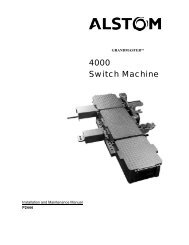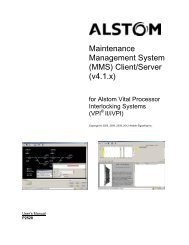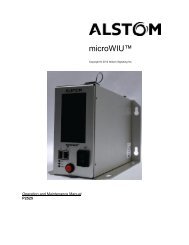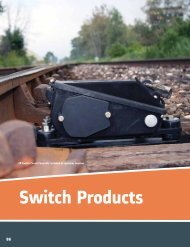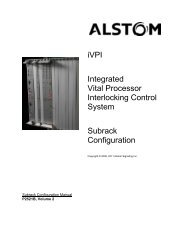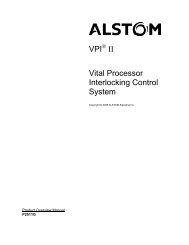Create successful ePaper yourself
Turn your PDF publications into a flip-book with our unique Google optimized e-Paper software.
Theory of Operation<br />
2.4.4.2. Microchron II Timer Relay (DC)<br />
Designed to replace existing DC motor timers, the Microchron II Timer Relay possesses<br />
a delay range from 1 second to 19 minute and 59 seconds. The range is adjustable in 1-<br />
second increments. Delay is initiated once input power is applied.<br />
The timing package consists of two printed circuit boards that perform time select and<br />
voltage regulation/relay driver and delay processing operations. The front edge of the<br />
delay processor provides visual indications of the delay sequencing. Those provided<br />
include ‘DELAY COMPLETE’ and ‘TIMING/POWER ON’. The time selection is<br />
accomplished by removing the cover from in front of the thumbwheel select switch<br />
assembly and placing the thumbwheels in the desired position.<br />
Four wires run external to the timer assembly: two wires for input power, that are<br />
terminated on the relay contact block and two wires that are connected to the B relay<br />
coils on the relay assembly. Connections between the timer and relay assemblies are<br />
accomplished using pin and socket type connectors.<br />
The relay mechanism consists of a B1 neutral relay with two series connected coils<br />
each with a nominal DC resistance of 250 ohms. Contact configuration is 3 fronts (silver<br />
impregnated carbon to silver), 2 backs (silver to silver impregnated carbon), and 2 frontback<br />
(silver impregnated carbon to silver, silver to silver).<br />
The Microchron II Timer is normally de-energized. Once power is applied, the<br />
microprocessor begins the vital program. Initially vital functions are tested and data<br />
memory is checked for failures. Next, the time selected on the thumbwheel switches is<br />
scanned and appropriate delay counters are initialized. The delay sequence then<br />
begins. The ‘TIMING/POWER ON’ indicator flashes at one-second intervals as the<br />
delay proceeds. A signature analysis following completion of the delay is a final check<br />
that all operations have been properly performed. Successful performance of the<br />
signature analysis allows the program to enter the vital output routine that provides a 10<br />
kHz signal needed to energize the B relay. The indicator ‘DELAY COMPLETE’ is<br />
illuminated at that time. Slight illumination of the ‘TIMING/POWER ON’ indicator<br />
provides visual indication that power is being applied to the unit.<br />
2.4.4.2.1. Operating Specifications<br />
• Input voltage (DC) : 8V to 31.5 VDC<br />
• Maximum Current Draw: 0.100 Amps @ 15VDC Input<br />
• Relay Maximum PICKUP and WORKING Current: 0.0121 Amps<br />
• Relay Coil Resistance (series connected coils): 500 ohms (Nominal)<br />
• Operating Temperature: -40°C to +70°C<br />
P1457, Rev. Nov/07 2–22 <strong>Alstom</strong> Signaling Inc.





